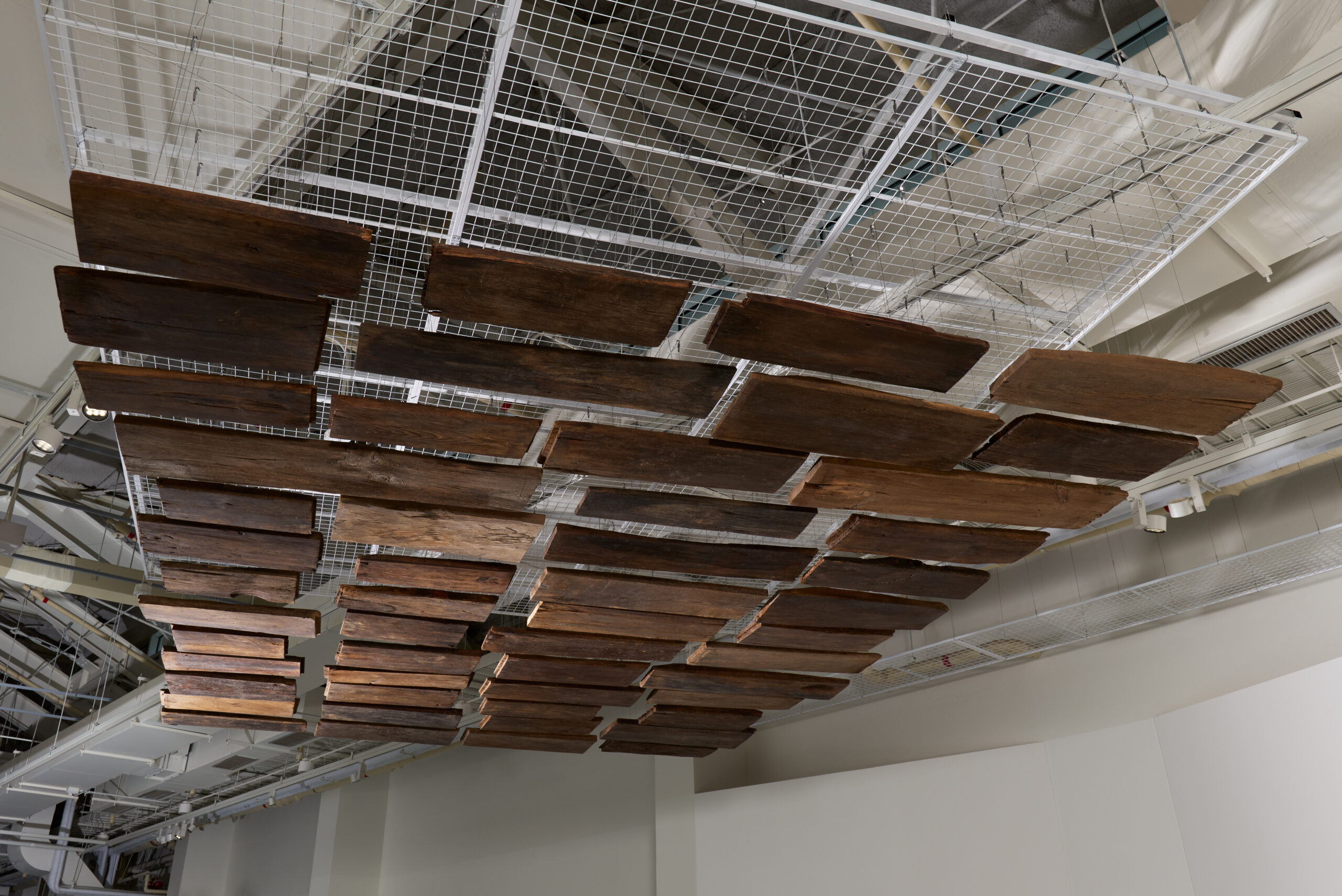정명택
Jung Myungtaek

1.
Maru 24-0151
한옥 마룻널
Hanok floorboards
300x400x5cm
2024
“한옥의 마루는 장식 없이 담백한 나무 널판으로 이루어져 있으며, 오랜 시간 동안 자연과 어우러져 살아온 한국인의 삶의 중심 공간이자 소통의 장소였다. 따라서 마루는 한국 전통의 정체성과 고유한 미를 담고 있으며, 한국인의 삶의 방식과 전통적 가치를 온전히 반영하고 있다.” – 작가노트 中
정명택은 자연주의적 미의식과 한국의 정체성에 집중하여 형태와 기능이 조화로운 아트퍼니처를 만든다. 그는 자연의 아름다움을 살리고, 자연과 인간이 조화롭게 공존하는 한국 고건축의 정신을 ‘무위(無爲)의 순수미’, ‘무심(無心)의 담백미’, ‘무형(無形)의 공간미’로 규정하고, 이러한 삼무(三無) 정신을 작품의 기본 개념으로 삼았다. ‹Maru› 시리즈는 1997년 서울리빙디자인 페어 때 대형 대청마루를 제작하면서 시작되었다. 그 후 2021년 개인전에서 수백 년간 사용된 한옥 대청의 마룻널을 140개의 스툴로 재해석한 작품을 선보였다. 작가는 “서양의 입식 문화를 대표하는 것이 의자라면, 우리 좌식 문화를 대표하는 것은 마루이지 않을까?”라고 생각하며 이 작업을 진행했다. 이번 전시에서 새롭게 선보이는 ‹Maru 24-0151›은 마루의 원형이 지닌 고정적인 기능, 형태, 구조, 의미를 다양한 관점에서 탐구한 설치 작업이다. 수백 년 동안 귀틀에 줄 맞춰 끼워져 있던 한옥의 마룻널을 천장에 전복하여 배치함으로써 한옥 공간의 개방적 무형성(無形性)을 관람객들에게 전달하고자 한다. 거꾸로 매달린 마루에서 재료의 순수함, 형태의 담백함, 공간과 어우러짐을 경험하고 그 안에 담긴 마루의 다양한 의미 체계를 발견하기 바란다.
“The floor of a Hanok, or the maru, is made of plain wooden boards without decorations, and it has traditionally been the central space of life and a place of communication for Koreans, who have long lived in harmony with nature. Therefore, the maru embodies the identity and unique beauty of Korean tradition, fully reflecting the Korean way of life and traditional values.”—excerpt from the artist statement
Jung Myungtaek focuses on naturalistic aesthetics and Korean identity, creating art furniture that harmoniously combines form and function. He highlights the beauty of nature through compositions that harmonize with the natural environment, and he defines the spirit of Korean architecture, where nature and humans coexist in harmony, as the “pure aesthetics of inaction,” the “simple aesthetics of mindlessness,” and the “spatial aesthetics of formlessness.” These three principles form the fundamental concept of his work. <Maru> series began in 1997 when he worked on crafting a large daecheongmaru (Korean wooden floor) at the Seoul Living Design Fair. About 20 years later, in 2021, he presented a work that repurposed Hanok floorboards, used for hundreds of years, into 140 stools. Reflecting on the question, “If chairs represent Western standing culture, wouldn’t the floor represent our sitting culture?”, the artist transformed wooden Hanok floors into stools. , newly presented in this exhibition, is an installation work that explores the fixed function, form, structure, and meaning of the original maru from various perspectives and seeks out new points of view. By freely arranging Hanok’s wooden floorboards, which have been fitted into the gwiteul (framework structures) for hundreds of years, on the ceiling, he seeks to convey the open formlessness of the Hanok space to visitors. The artist hopes that by appreciating the maru hanging upside down, viewers can experience the purity of materials, the simplicity of form, and the harmony of space and freely discover the various meanings of maru contained within it.
공예로 짓는 집
Crafting the House
2024.9.5-2025.3.9.

